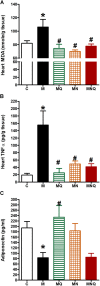A Nano-Pharmaceutical Formula of Quercetin Protects from Cardiovascular Complications Associated with Metabolic Syndrome
- PMID: 34456723
- PMCID: PMC8385560
- DOI: 10.3389/fphar.2021.696981
A Nano-Pharmaceutical Formula of Quercetin Protects from Cardiovascular Complications Associated with Metabolic Syndrome
Abstract
Metabolic syndrome (MetS) is closely associated with the development of cardiovascular diseases. We recently developed a nano-preparation of the flavonoid quercetin (QU) in a self-nanoemulsifying drug delivery system (SNEDDS). The latter comprised a mixture composed of pumpkin seed oil, D-α-Tocopherol polyethylene glycol 1,000 succinate and polyethylene glycol. The QU SNEDDS preparations exhibited a considerably higher bioavailability compared with the standard quercetin suspension. Here, we investigated whether the quercetin loaded SNEDDS could offer better protection compared with the standard formulation against cardiovascular complications of MetS in rats. MetS was induced by high fructose, high salt and high fat diet for 12 weeks while the nano-preparation or the standard suspension of quercetin was orally administered for the last 6 weeks. Compared to little effect for the standard quercetin suspension (MQ), the treatment of MetS rats with the quercetin loaded SNEDDS (MNQ) virtually abolished the depressant effect of MetS on contractility index (control, 114 ± 4; MetS, 92 ± 3; MQ, 100 ± 2; MNQ, 114 ± 6 1/s) and rate of rise in left ventricular pressure (dP/dtmax) (control, 8,171 ± 274; MetS, 6,664 ± 135; MQ, 6,776 ± 108; MNQ, 7,498 ± 303 mmHg/s). Likewise, the prolongation by MetS of electrocardiographic markers of arrhythmogenesis (QTc, JT, and Tpeak-to-Tend intervals) and concomitant rises in dicrotic notch pressure were preferentially reversed by quercetin nano-preparation. On the other hand, the rises in the isovolumic relaxation constant (Tau, denotes diastolic dysfunction), blood pressure, pulse pressure, and difference between systolic and dicrotic pressure (SDP difference) were equally improved by the two preparations of quercetin. Additionally, no differences were noted in the ability of the two quercetin preparations in abrogating the elevated oxidative (MDA) and inflammatory (TNFα) markers in cardiac tissues of MetS rats. Histopathological, microscopical signs of necrosis, inflammatory cell infiltration, and vascular congestion in MetS hearts were more markedly inhibited by the nano-preparation, compared with the standard preparation of quercetin. In conclusion, the quercetin loaded SNEDDS is evidently more advantageous than the standard preparation of the drug in alleviating functional and histopathological manifestations of cardiac damage incited by MetS.
Keywords: SNEDDS; cardiovascular complications; metabolic syndrome; nano-formulation; quercetin.
Copyright © 2021 Ahmed, Hassan, Azhar, El-Mas and El-Bassossy.
Conflict of interest statement
The authors declare that the research was conducted in the absence of any commercial or financial relationships that could be construed as a potential conflict of interest.
Figures






Similar articles
-
Rp-HPLC Determination of Quercetin in a Novel D-α-Tocopherol Polyethylene Glycol 1000 Succinate Based SNEDDS Formulation: Pharmacokinetics in Rat Plasma.Molecules. 2021 Mar 6;26(5):1435. doi: 10.3390/molecules26051435. Molecules. 2021. PMID: 33800848 Free PMC article.
-
Self-Nanoemulsifying Drug Delivery System Loaded with Psiadia punctulata Major Metabolites for Hypertensive Emergencies: Effect on Hemodynamics and Cardiac Conductance.Front Pharmacol. 2021 Jun 10;12:681070. doi: 10.3389/fphar.2021.681070. eCollection 2021. Front Pharmacol. 2021. PMID: 34177590 Free PMC article.
-
Quercetin-containing self-nanoemulsifying drug delivery system for improving oral bioavailability.J Pharm Sci. 2014 Mar;103(3):840-52. doi: 10.1002/jps.23858. Epub 2014 Jan 24. J Pharm Sci. 2014. PMID: 24464737
-
From nanoemulsions to self-nanoemulsions, with recent advances in self-nanoemulsifying drug delivery systems (SNEDDS).Expert Opin Drug Deliv. 2017 Nov;14(11):1325-1340. doi: 10.1080/17425247.2016.1218462. Epub 2016 Aug 11. Expert Opin Drug Deliv. 2017. PMID: 27485144 Review.
-
Self-nanoemulsifying drug delivery systems: formulation insights, applications and advances.Nanomedicine (Lond). 2010 Dec;5(10):1595-616. doi: 10.2217/nnm.10.126. Nanomedicine (Lond). 2010. PMID: 21143036 Review.
Cited by
-
Quercetin: A Flavonoid with Potential for Treating Acute Lung Injury.Drug Des Devel Ther. 2024 Dec 6;18:5709-5728. doi: 10.2147/DDDT.S499037. eCollection 2024. Drug Des Devel Ther. 2024. PMID: 39659949 Free PMC article. Review.
-
Rosuvastatin, but not atorvastatin, enhances the antihypertensive effect of cilostazol in an acute model of hypertension.Naunyn Schmiedebergs Arch Pharmacol. 2024 Apr;397(4):2321-2334. doi: 10.1007/s00210-023-02758-1. Epub 2023 Oct 11. Naunyn Schmiedebergs Arch Pharmacol. 2024. PMID: 37819392 Free PMC article.
-
Decreased blood pressure with acute administration of quercetin in L-NAME-induced hypertensive rats.Basic Clin Pharmacol Toxicol. 2025 Jan;136(1):e14113. doi: 10.1111/bcpt.14113. Basic Clin Pharmacol Toxicol. 2025. PMID: 39702745 Free PMC article.
-
Regulation of airway remodeling in asthma: The synergistic effects of nanotechnology and Hippo pathway activation.APL Bioeng. 2025 Jul 18;9(3):036105. doi: 10.1063/5.0251258. eCollection 2025 Sep. APL Bioeng. 2025. PMID: 40688245 Free PMC article.
References
-
- Ahmed O. A. A., Azhar A. S., Tarkhan M. M., Balamash K. S., El-Bassossy H. M. (2020). Antiglycation Activities and Common Mechanisms Mediating Vasculoprotective Effect of Quercetin and Chrysin in Metabolic Syndrome. Evid. Based Complement. Alternat Med. 2020, 3439624. 10.1155/2020/3439624 - DOI - PMC - PubMed
LinkOut - more resources
Full Text Sources

